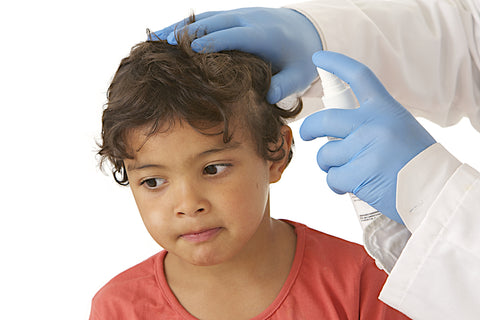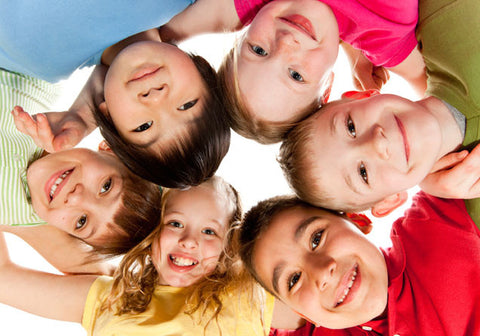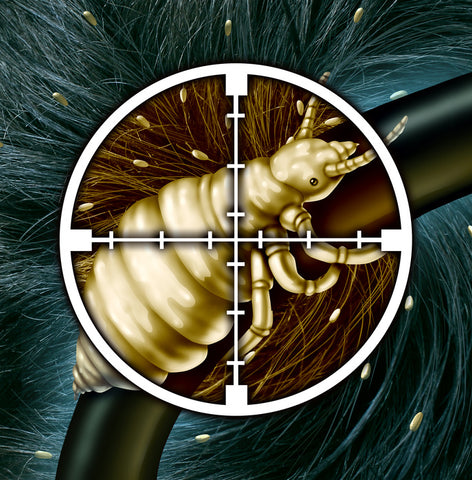LiceGuard News
Stay LICE FREE this Back-to-School Season! 0
Back to school time is here, and for many parents that means a return to the reality of dealing with lice! There are many ways to attempt to prevent lice, yet educating yourself and your children is crucial.
If your child does bring home lice, try not to panic! Lice don’t spread any diseases and they do not indicate that your child or home is dirty. In reality, lice prefer squeaky clean hair to grip on to!
First, the facts. Head lice don’t jump, they only crawl, which is why they are so prevalent in young daycare and school-aged children (most commonly from ages 3 to 11) who spend long periods of time in close quarters. Even adult lice are miniscule; they are only about 2 to 3 millimeters in length. Lice feed off the blood of the scalp and lay their eggs on the hair shaft close to the scalp. The itchiness commonly associated with a case of head lice is from an allergic reaction to the bites of the louse. Some children may also report that they feel something crawling in their hair or have trouble sleeping at night as lice are more active when it is dark. A lice egg is called a nit; they are extremely small and appear white or pale yellow and are very hard to see. After the eggs are laid, they grow for about 8 to 9 days before hatching. As they grow, they become easier to see, which is why you need to continue to check daily for the louse’s full lifecycle. The key to successfully eradicating lice is to interrupt the lifecycle of the louse, or said differently, you want to remove all of the adults so they can’t lay anymore eggs. An immature louse is called a nymph, and nymphs take 9 to 12 days to reach maturity where they can begin to lay their own eggs. This is why you will still need to check the hair daily for 14 days to make sure you have removed ALL the eggs and nits.
You should also be aware of the lice and nit policy at your school. Some schools send children home and will not let them come back to school until they are completely lice and egg free. This is commonly called a “no-nit policy.” It’s a struggle for parents and children to miss school and work to handle a case of lice. But some districts are moving in a different direction. In an article in Slate Magazine, Dan Kois discusses his children’s school’s new lice policy:
“If a child has lice in her hair, the nurse will contact parents but send the child back to the classroom for the rest of the day. Parents are expected to treat the lice, but no one is checking in to enforce this expectation. No classes or groups will be screened for bugs. “No healthy child,” the policy reads, “should be excluded from or miss school because of head lice… Arlington’s new stance on lice is being adopted by schools all over the country, encouraged by the American Academy of Pediatrics and the National Association of School Nurses. And it’s the right one. Lice are not particularly contagious, they hurt basically no one, and they’re not a public health risk. Lice don’t actually matter. It’s high time that squeamish parents and school administrators stop acting like they do.”
It’s an interesting and progressive policy but unlikely to be widely adopted anytime soon. For now, as parents hear the word “lice.” it requires an immediate call to action. Until lice policies change nationwide, here are some ideas to prevent lice in the school or daycare setting, and keep your children engaged and learning at school!
Keep long hair pulled back in a ponytail, braid or bun. There are lots of fun styles and accessories to try so that kids don’t have to sacrifice style for freedom from lice. Of course, kids should not share the cute headbands, clips and scrunchies as lice can hitch a ride on these kinds of accessories and survive for up to two days without a human host.
Along the same lines, you should tell your kids not to share scarves and hats! With winter approaching, hats and scarves are set to escape their bins, and while it may seem like common sense not to share hats, scarves can be just as complicit when it comes to spreading lice. Remind kids that lice like the warm areas behind the ears and at the nape of the neck - exactly where their scarves rest!
If your children are involved in theater (think wigs, hats, costumes being swapped around the cast) or sports (with helmets, jerseys, towels shared amongst the team) consider investing in your child’s own equipment or give your child a quick spray with a lice repellent before heading out the door!
Want a NON-TOXIC and proven way to protect against lice at school?
Buy the RobiComb® Today and Kill the Lice on Contact!
No Chemicals. Safe for Kids.
Buy Today at Your Local Pharmacy
- LiceGuard Webmaster
Chemical Treatments are Dangerous - LiceGuard 0

The panic you feel when you find out that your child has lice is palpable. Your heart starts racing and sinks to the floor, you scratch your head as you imagine that you must have lice too! You become overwhelmed with the knowledge that there are lice in your home and that you need to clean everything immediately. So you race to the store and buy the harshest chemicals you can in order to kill all the bugs as fast as possible!
However, that is just the fear causing you to act. Stop, take a deep breath and weigh your options. It is best to be knowledgeable about lice treatment options if you really want to get rid of lice safe and effectively.
The truth is that most traditional over-the-counter chemical lice treatments are ineffective. Lice have evolved over the years and have become resistant to these chemical treatments. In recent years, news outlets have heavily discussed the topic of Super lice, the new strain of critters that cannot be treated with traditional chemical lice treatments.
While Super lice have been getting much press lately, the treatment of Super lice goes back fifteen to twenty years. John Clark, a toxicologist at the University of Massachusetts at Amherst, has been warning parents and professionals about just this phenomenon. A September 12, 2002 article published by the University states the following:
“Most commercial anti-louse shampoos are based on the pyrethrins, an extract that is derived from chrysanthemums which has low toxicity to humans. The problem, according to Clark, is that similarly acting compounds, such as DDT, have been used for more than 60 years in getting rid of lice, and more and more of the insects, which live only on human heads, are surviving the treatments. Essentially, lice vulnerable to the treatments are being slowly killed off, and those that can withstand it are surviving and reproducing, creating a strain of hardy survivors. That translates into a best-case scenario for the lice, and a worst-case scenario for humans, said Clark, who points to studies finding that 50 to 98 percent of the parasites remain after being exposed to these insecticides.”
Sitting in 2017, we have arrived at the worst case scenario: lice are no longer succumbing to traditional chemical lice treatments and we are exposing our children to these chemicals. Chemicals, it should be mentioned, which we are advised to apply with gloves on our hands to our children’s scalps with no promise of actually solving the problem. To make matters worse, chemical lice shampoos do nothing to lice eggs (nits) and thus the cycle of lice in our children’s heads continues.
Product watchdogs Consumer Reports recently published an article with the following findings, “There’s no reason for parents to douse their children’s heads in chemicals,” says Urvashi Rangan, Ph.D., Director of Consumer Safety and Sustainability for Consumer Reports. “Physically removing lice, while it seems daunting, is safest for your child’s head.”
The toxic over-the-counter products are losing their fight against lice because studies suggest that most of the bugs in the United States have evolved to become genetically resistant to the insecticides found in those products. That includes pyrethrum in shampoos such as RID and the permethrin in creme rinses such as Nix. Pyrethrum is a naturally occurring pyrethroid extract from the chrysanthemum flower, and permethrin is a synthetic form of that drug. Products with those toxic ingredients have been available to consumers for decades!
A study published in the March 2014 issue of the Journal of Medical Entomology found that 99 percent of the head lice collected by school nurses and professional lice combers in 12 states and three Canadian provinces were genetically resistant to permethrin. “It’s not surprising that we are seeing a resistance to these products,” Rangan says. “That’s what happens with insecticides and pests over time.”
Luckily there are other safer, more effective options to treat both lice and Super lice. While you can find many home remedies for lice treatments, such as garlic, mayonnaise, petroleum jelly, coconut oil and many other substances people swear by, it’s best to read up on what the experts recommend. Most of the home remedies won’t do much more than frustrate you and your child and make a stinky mess.
The tried and true best way to eradicate lice is with time and patience. Though it may feel counterintuitive, we know there must be a physical removal process to break the cycle, and that takes time. A good lice comb and a conditioning shampoo that loosens the nit glue will get rid of lice and the eggs. Make no mistake, there is no silver bullet, it’s a long process. However, for the safety of our children it is so very worth it! Diligent and consistent combing daily for 14 days will safely and completely eliminate the infestation.
Want a NON-TOXIC and proven way to protect against lice infestations?
Buy the RobiComb® Today and Kill the Lice on Contact!
No Chemicals. Safe for Kids.
Buy Today at Your Local Pharmacy
- Carson Shopify
Summer Camp Lice Prevention Tips - LiceGuard 0

Summer is in full swing and for 7.2 million children in the United States that means time for camp (and sleepovers!) The American Camp Association recognizes 8,400 overnight camps; that's a lot of campers sharing close quarters! Lice are among the most common problems that camps have to deal with. An article published by Lisa O'Neill Hill on CNN states, "We see increased cases after children have spent extended periods of time in the community." Many camps screen for head lice when children arrive, while others send letters to parents telling them to check their children for lice before camp starts.
When sending your kids off to camp, parents need to educate even the youngest of campers on how to prevent lice. One of the most important lice prevention tips to teach kids is what NOT to share. Hair ties, hats, helmets, head bands, bathing caps, etc. are tempting to trade, but should never be shared. Empower your kids to just say no to sharing certain items. Other important items to remind children not to share are towels, pillows, combs and brushes.
Find out the lice and nit policy at the camp before you commit. It may not seem as critical as remembering to pack your child's sunscreen, but it's good to know in advance, especially if the camp is far away from your home or travel is planned while the kids are away. Unfortunately, the reality is that most camps do have a no-nit policy and will send affected children home.
Some camps do screenings for lice upon the campers’ arrivals and hire nit pickers to treat any cases that arise. Services can include manually removing lice and nits, and using a high-heat dryer to kill any lice on clothes and bedding. These services can come with an added cost to the family, so be sure to ask before agreeing to have it taken care of by the camp. Some camps go a more basic route with over-the-counter chemical shampoos but it’s important to remember that the majority of lice are resistant to chemical treatments and you will want to know exactly what the camp staff is going to use on your child before you okay it. Other options can include taking the camper home and treating them yourself. It’s important to weigh the cost-benefit of both options and be sure that you and your child are comfortable with the solution presented by the camp.
Many camps also encourage preventative measures before sending children to camp. Checking your child, or even having your child checked professionally, and using lice repellents can offer peace of mind to the child and the parents. One great idea is to teach your children to use a lice repellent spray every morning before and during camp to keep these pests away. Additionally, teach children with long hair how to braid, or at least to do a tight pulled back bun or pony tail. YouTube and beauty bloggers have lots of “how to” videos with some really fun and easy up-do hair styles.
If your child does exhibit signs of lice (itchy head, tickling feeling behind the ears, at the back of the neck or on the scalp) or finds that a bunkmate has lice while at camp, tell them to remain calm and speak with a camp counselor about their concerns privately. Lice are not something to panic or become upset about. Explain to your child that it is very common and the sooner that they do something about it, the better. The worst thing would be if he or she was too afraid or too ashamed to speak to a counselor and their lice gets worse and potentially spreads. Remember lice is not a disease, it's a nuisance which is VERY treatable.
When your kids come home from overnight camps there are some things you can do make sure that no lice hitched a ride back to infest your home! Washing items does not kill lice but drying on high heat will. Take any bedding and put it in the dryer on the highest heat possible for at least 20 minutes. Don't forget about stuffed animals! If you cannot put certain items in the dryer, seal them in a plastic bag for at least 2 weeks to ensure any potential lice are killed. Lice need to feed off human blood and will die if they do not feed after 14 days. Continue to check your child for 10-14 days after camp to make sure they are truly home free. The sooner you find the lice, the quicker you can nip them in the bud! Even post camp season, doing weekly lice checks throughout the year is a great habit to get into.
Dealing with a Lice Infestation from camp?
Buy the RobiComb Today and Kill the Lice on Contact!
No Chemicals. Safe for Kids.
Buy Today at Your Local Pharmacy
- LiceGuard Webmaster
Social Media Lice 0

In the current smartphone era, lice are no longer just a nuisance in local elementary schools. A trend which has been dubbed “social media lice” has led to an uptick in head lice cases in teenagers nationwide. Caused by youths cramming their heads together to take “selfies,” lice are transferred on contact and doctors are taking note of this surge in teenagers with lice, something that was unheard of five years ago. In fact, the trend is causing some school associations to rethink their “no-nit” policies, as evidenced by school officials in Brookings, Oregon. As the spreading of lice continues to evolve in creative ways, so must schools to combat absenteeism and the hidden costs of these pesky parasites.
Lice prevalence is quite common in the United States, with the CDC estimating that up to 12 million infestations occur every year. Female lice can lay up to six eggs, or nits, every day. Eggs are laid on the shaft of hair and those less than six millimeters from the scalp are most likely to hatch. Nits are glued on to the hair by secretions from the female louse. Anyone can technically get lice, although they are most common in small children due to the constant sharing of hats, toys and close contact through playing.
There is often a negative stigma that accompanies contracting lice, however lice are not a health hazard and they are not a sign of poor hygiene. In most school settings, when nits are found in children’s hair they are sent home to avoid spreading the infestations further. This act of removing children from school is known as a “no-nit” policy, and it often leads to shame and embarrassment. This ostracism is only worse in teenage settings and can have a damaging effect on self-esteem.
Through the guiding hands of district school nurse Alice Sandusky, the Brookings-Harbor School Board recently approved a new policy which will keep children with head lice in school to avoid unnecessary embarrassment and cut down on absences. Sandusky points out that, “lice cannot be spread as easily as people might think. The norovirus and the flu spread more easily.” What will the school system do instead? The answer is that both students and parents will be educated as to how to both eliminate and prevent head lice. Although surprised given the prevalence of the traditional “no-nit” policy, District Superintendent Sean Gallagher was relieved that the school district’s policy is changing in order to combat chronic absenteeism.
In fact, Sandusky said the American Academy of Pediatrics, the CDC and the National Association of School Nurses advocate that no-nit school policies should be discontinued for the following reasons:
- Many nits are more than a quarter-inch from the scalp. Such nits are usually not viable and very unlikely to hatch to become crawling lice — and often are empty shells, also known as “casings;”
- Nits are cemented to hair shafts and are very unlikely to transfer successfully to other people; and
- The burden of unnecessary chronic absenteeism to the students, families and communities far outweighs the risks associated with head lice.
All this sounds great, but what does this mean for parents of school-aged children? While no-nit policies may be trending towards extinction, the fact still remains that lice prevalence in schools remain a problem and that “social media lice” aren’t the last lice fad which will create havoc in school settings. Sandusky’s goal, and one which is shared by many of those fighting on the front lines, is to continue to educate parents and children. Children and teens alike need to be cognizant of sharing their personal space when taking photos, and parents need to be diligent in continuously checking their kids’ hair for lice and nits.
Dealing with a Lice Infestation in Your Home?
Buy the RobiComb Today and Kill the Lice on Contact!
No Chemicals. Safe for Kids.
Buy Today at Your Local Pharmacy



- Carson eCommerce Collaborator
Head lice is a widespread problem! 0
The Centers for Disease Control and Prevention (CDC) estimate that up to 12 million children aged 3 to 12 contract lice in the United States each year!
Pediatrics, the Official Journal of the American Academy of Pediatrics, cites studies that claim that 12 to 24 million days of school annually are lost to lice infestations and schools' 'no nit' policies. AND the economic burden for parents is mounting! Pharmacotherapy alone costs the United States economy $240 million per year and estimates for direct and indirect costs may be as high as $1 billion per year!
Don't get bogged down in the expenses, make it simple and buy a RobiComb from LiceGuard! Click here to see where the RobiComb is sold!

- LiceGuard Webmaster







